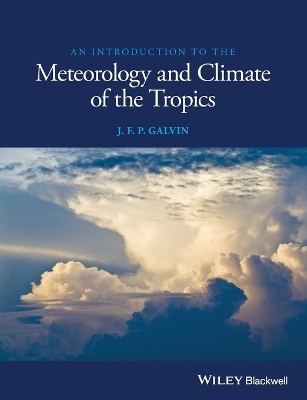
An Introduction to the Meteorology and Climate of the Tropics
Wiley-Blackwell (Verlag)
978-1-119-08622-2 (ISBN)
This book was written for weather forecasters, meteorology, environmental science and geography students as an introductory guide. It builds on the experience of the author, his professional experience in the World Area Forecast Centre at the Met Office, Exeter, using studies into the weather and climate seen within the tropical air mass conducted over many years. Its unique approach presents a practical approach to tropical weather studies, drawing on both academic and practical knowledge, covering air mass dynamics, seasonal changes, moist and dry weather, climate variability and human health in chapters and appendices that build up the overall picture, summarising our current state of knowledge.
As an overview, it covers the broad range of effects connected with climate and weather in a straightforward way and is clearly illustrated throughout.
Jim Galvin has had a long interest in tropical meteorology. He is a Senior Operational Meteorologist in the Met Office World Area Forecast Centre in Exeter, UK and also produces the Shipping Forecast. In 2014, he became Editor of the RMetS journal Weather. He enjoys photography and singing in a choir.
About the Author xi
Preface xii
Acknowledgements xiii
1 Setting the Scene 1
1.1 Introduction 1
1.2 What do we mean by ‘the tropics’? 2
1.3 The geography of the tropics 5
1.4 The tropical troposphere 5
1.5 Climate and population in the tropics 7
1.6 Question 8
2 The Energy Balance and the Dynamics of Weather in the Tropics 9
2.1 The tropical ‘heat engine’ 9
2.2 Absorption, reflection and apparent solar elevation 9
2.3 Emission from the surface 11
2.4 The radiation balance and the tropical zone 12
2.5 The dynamics of weather systems in the tropics 14
2.6 Questions 15
3 Winds, Temperature and Weather in the Tropical Zone 16
3.1 Winds 16
3.2 Temperature 20
3.3 The weather patterns and climates of the tropics 21
3.4 Clouds and fog in the tropics 23
3.5 Questions 28
4 The Subtropical Jet Streams 29
4.1 The formation of jet streams at the margins of the tropics 29
4.2 Weather associated with the subtropical jet stream 31
4.3 Folds and bifurcations in the flow 33
4.4 Clear‐air turbulence 34
4.5 Questions 36
5 Synoptic‐scale Weather Systems 38
5.1 Introduction 38
5.2 Convection in the tropics 38
5.3 The inter‐tropical convergence zone 42
5.4 The depth of convective clouds 47
5.5 Layer clouds and shallow convection 48
5.6 The effects of heavy rainfall in the tropics 48
5.7 Atmospheric teleconnections 49
5.8 Questions 49
6 Climate, Flora and Fauna 51
6.1 The relationship of climate to plants and animals 51
6.2 Tropical rainforest 51
6.3 Seasonal tropical forest 57
6.4 The savannas 58
6.5 Tropical deserts and scrublands 60
6.6 Mountain climates 61
6.7 Tropical oceans and coasts 65
6.8 Climatic variability 67
6.9 Questions 68
7 Dry Environments 69
7.1 Background 69
7.2 Wind and weather in the deserts 70
7.3 Fog and low cloud 78
7.4 Severe weather in the dry tropics 79
7.5 The effects of desert weather 82
7.6 Settlement and the over‐use of scarce water supplies 84
7.7 Questions 85
8 Monsoons 86
8.1 Introduction 86
8.2 The summer monsoon over southern Asia 86
8.3 The summer monsoon over East Asia 89
8.4 Variations of rainfall in the Asian summer monsoon 93
8.5 The Asian winter monsoon 94
8.6 The West African summer monsoon 96
8.7 The West African winter monsoon 103
8.8 Rainfall and the monsoons in East Africa 104
8.9 The South American–Caribbean ‘monsoons’ 106
8.10 The Australian summer monsoon 107
8.11 Variable broad‐scale factors affecting the monsoons 111
8.12 Questions 112
9 Tropical Revolving Storms 114
9.1 Broad‐scale convection and the development of tropical storms 114
9.2 Tropical storm development and decline 114
9.3 The effects of tropical revolving storms 120
9.4 Storm tracks in the Pacific Ocean 124
9.5 The formation and tracks of hurricanes in the North Atlantic–Caribbean 125
9.6 Tropical cyclones in the Indian Ocean 126
9.7 Tropical revolving storms in the south‐west Pacific 127
9.8 Variability in the development of tropical storms 128
9.9 Extra‐tropical transition 132
9.10 Conclusion 132
9.11 Questions 132
10 Mesoscale Weather Systems 134
10.1 Introduction 134
10.2 Mesoscale convective complexes 134
10.3 Sea‐ and land‐breeze convergence zones 135
10.4 Easterly waves and squall lines 139
10.5 Mesoscale convective systems in northern India 143
10.6 Depressions in north‐west India, north Pakistan and Afghanistan 144
10.7 Cross‐equatorial flows 144
10.8 Mesoscale convective systems in the Gulf of Guinea 145
10.9 Local convection 145
10.10 Extra‐tropical interaction with moist tropical air masses 148
10.11 Conclusion 148
10.12 Questions 149
11 Forecasting Clouds and Weather 150
11.1 Background 150
11.2 Distribution of significant cloud 150
11.3 The effect of high ground as an elevated heat source 155
11.4 Tropical upper‐tropospheric troughs 157
11.5 Effects of severe convection on aviation 159
11.6 Questions 162
12 The Variability of Weather and Climate Change in the Tropics 164
12.1 Introduction 164
12.2 El Niño–La Niña 164
12.3 The Madden–Julian Oscillation 166
12.4 The quasi‐biennial oscillation 168
12.5 A discussion of anthropogenic climate change 171
12.6 How is climate likely to change in the tropical zone? 172
12.7 Modelling climate change 175
12.8 Conclusion 176
12.9 Questions 176
13 Tropical Agriculture 177
13.1 Agricultural productivity and tropical environments 177
13.2 Agriculture in the humid tropics and the effects of forest clearance 178
13.3 Agriculture in the savannas 180
13.4 Dry‐land agriculture 180
13.5 Weather and locust swarms 182
13.6 The effects of agriculture in the tropics 183
13.7 Agriculture and climate change 185
13.8 Question 186
14 The Importance of the Tropical Ozone Layer 187
14.1 Background 187
14.2 The role of the tropics in replenishing the extra‐tropical stratospheric ozone 191
14.3 The effect of ‘global warming’ on stratospheric ozone destruction in the tropics 193
14.4 The effects of exposure to short‐wave radiation 194
14.5 Current state of the stratospheric ozone layer 195
14.6 Question 195
15 Remote Sensing of Tropical Weather 196
15.1 Background 196
15.2 Satellite remote sensing 196
15.3 Precipitation 197
15.4 Wind profilers 199
15.5 Thunderstorm observation 199
15.6 Monitoring surface cover, fires and volcanic eruptions 199
15.7 Question 202
16 Tropical Weather and Health 203
16.1 Introduction 203
16.2 The effects of tropical sunshine and warmth 203
16.3 Lifted dust and its effects on health 203
16.4 Industrial and smoke pollution 204
16.5 Parasitic and infectious diseases 204
16.6 Response of the meteorological community 206
16.7 Questions 206
17 Conclusions and a Look to the Future 207
17.1 A summary 207
17.2 Forecasting the weather 208
17.3 Questions 208
Appendix 1 Observations from the Tropics 209
Appendix 2 Named Winds of the Tropics 213
Appendix 3 An Introduction to Cloud Types, Cloud Species and Precipitation 234
A3.1 Introduction 234
A3.2 The high clouds 235
A3.3 The medium‐level clouds 235
A3.4 The low clouds 236
A3.5 Cloud species and varieties 239
Appendix 4 An Introduction to Meteorological Diagrams, Stability, Instability and Aviation Weather Charts 246
A4.1 Temperature–pressure graphs 246
A4.2 Stability and instability 248
A4.3 Aviation‐significant weather charts 248
Appendix 5 Snow in the Desert: A Case Study 250
A5.1 Introduction 250
A5.2 Development of a depression over the desert 250
A5.3 The weather features associated with the upper low 253
A5.4 Summary 256
Appendix 6 A Climatic Summary for Tropical Countries and States 257
Appendix 7 Two Easterly Waves in West Africa in Summer 2009: A Case Study 265
A7.1 Introduction 265
A7.2 The wave of 28 August to 5 September 2009 266
A7.3 The wave of 2–11 September 2009 and the development of Hurricane Fred 270
A7.4 A model for the development of squall lines in the Sahel 272
A7.5 Conclusion 277
References 280
Glossary 293
Index 303
| Verlagsort | Hoboken |
|---|---|
| Sprache | englisch |
| Maße | 191 x 246 mm |
| Gewicht | 726 g |
| Themenwelt | Naturwissenschaften ► Geowissenschaften ► Geografie / Kartografie |
| Naturwissenschaften ► Geowissenschaften ► Geologie | |
| Naturwissenschaften ► Geowissenschaften ► Meteorologie / Klimatologie | |
| ISBN-10 | 1-119-08622-1 / 1119086221 |
| ISBN-13 | 978-1-119-08622-2 / 9781119086222 |
| Zustand | Neuware |
| Haben Sie eine Frage zum Produkt? |
aus dem Bereich


